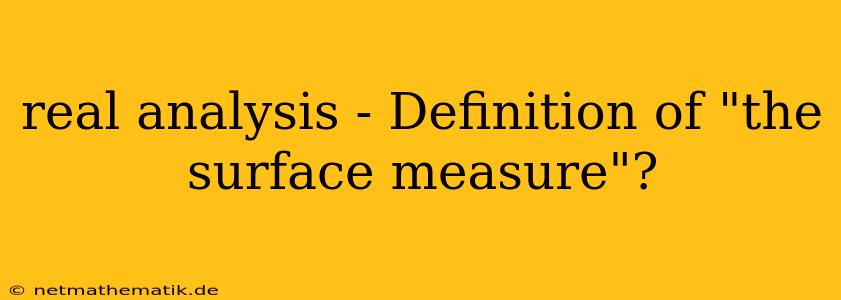The Surface Measure: A Key Concept in Real Analysis
In the realm of real analysis, the concept of surface measure emerges as a fundamental tool for quantifying the size or extent of surfaces in multi-dimensional spaces. It generalizes the familiar notion of length in one dimension and area in two dimensions to higher dimensions. Essentially, the surface measure assigns a numerical value, representing the "size" of a surface, which is a geometric object of dimension one less than the ambient space. This article delves into the definition and significance of the surface measure within the framework of real analysis.
Understanding the Need for Surface Measure
Before diving into the formal definition, let's understand why we need the concept of surface measure. In real analysis, we often encounter scenarios where we need to calculate integrals over surfaces. These surfaces could be boundaries of regions, graphs of functions, or more complex geometric objects. For instance, we might be interested in calculating the flux of a fluid across a surface or the total charge distribution on a curved conductor.
To perform these calculations, we need a way to measure the "size" of the surface. This is where the surface measure comes into play. It provides a way to assign a value to the area of a surface, regardless of its shape or complexity.
Formal Definition of Surface Measure
The surface measure can be defined in various ways, depending on the context and level of mathematical rigor desired. Here, we present a simplified definition suitable for an introductory understanding:
For a smooth surface S in n-dimensional Euclidean space (R^n), the surface measure σ(S) is defined as the integral of the norm of the cross product of the tangent vectors spanning the surface:
σ(S) = ∫_S ||∂u/∂s × ∂u/∂t|| ds dt,
where:
- u(s, t) is a parametrization of the surface S, with s and t being parameters.
- ∂u/∂s and ∂u/∂t are the partial derivatives of u with respect to s and t, representing tangent vectors.
- ||.|| denotes the norm (length) of a vector.
- ds dt represents the area element on the parameter space.
Intuitively, the surface measure is calculated by dividing the surface into infinitesimal patches, computing the area of each patch using the norm of the cross product of the tangent vectors, and then summing up the contributions from all the patches.
Properties of Surface Measure
The surface measure possesses several important properties that make it a powerful tool in real analysis:
- Non-negativity: The surface measure of a surface is always non-negative.
- Additivity: If two surfaces are disjoint, the surface measure of their union is the sum of their individual surface measures.
- Invariance under rigid motions: The surface measure is invariant under rotations and translations of the surface.
- Scaling: The surface measure scales by a factor of k^n-1 when the surface is scaled by a factor of k.
Significance of Surface Measure in Real Analysis
The surface measure plays a crucial role in various branches of real analysis:
- Integration over surfaces: The surface measure enables us to define integrals over surfaces. These integrals are essential for calculating quantities like flux, potential, and charge distribution.
- Surface area: The surface measure provides a way to calculate the surface area of complex geometric objects.
- Geometric measure theory: The surface measure is a key concept in geometric measure theory, which studies the properties of sets and measures in Euclidean space.
- Differential geometry: The surface measure is used to define the concept of a Riemannian manifold and its associated metric.
- Partial differential equations: The surface measure appears in boundary conditions for partial differential equations that describe physical phenomena occurring on surfaces.
Conclusion
The surface measure is a fundamental concept in real analysis that allows us to quantify the "size" of surfaces in multi-dimensional spaces. It is a powerful tool for integrating over surfaces, calculating surface area, and studying the properties of sets and measures in Euclidean space. Its significance extends across various branches of mathematics, making it an indispensable concept for researchers and students alike. Understanding the definition and properties of the surface measure is crucial for grasping many key concepts in real analysis and its applications in various fields of science and engineering.
